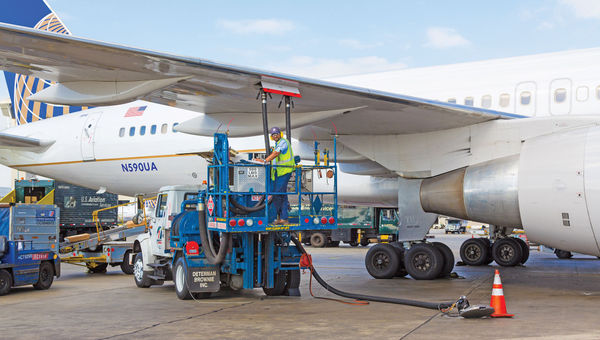Airlines will continue to be challenged by the pilot shortage in 2019. Carriers' use of IATA's New Distribution Capability (NDC) sales platform will grow significantly. Thanks to technology, passengers will enjoy smoother airport journeys. And the big question mark relating to airline operations and ticket prices will be fuel costs.
Those are some of the predictions that industry experts are making as 2019 approaches.
Fueled by mandatory retirements at age 65 and inadequate recruitment, the U.S. commercial airline industry will face a shortfall of between 4,000 and 5,000 pilots next year, according to an analysis by Flightpath Economics, which researches the pilot shortage.
Martin Rottler, industry relations coordinator at Ohio State University's Center for Aviation Studies, predicted that the shortage will continue to fall most heavily on regional airlines as more of their pilots move up to mainline carriers. As a result, Rottler said, regional carriers, many of which operate small-market flights for mainline carriers American, Delta and United, could face more day-to-day scheduling difficulties.
He added that the shortage could lead to more mergers and bankruptcies in the regional sector in 2019. "We see some consolidation that has already occurred, and there is definitely an appetite for more," Rottler said.
Great Lakes Airlines, which shut down operations, was the primary casualty of the pilot shortage in 2018.
The past year also brought the start of pilot career path programs by American, Delta and United as the carriers endeavor to improve long-term recruitment efforts. Rottler said he expects Southwest to launch a pilot career path program of its own in 2019.
More broadly, said John Grant, senior analyst for the airline analytics company OAG, growing pilot demand in Asia will continue to fuel the shortage, with pilots from across the globe gravitating to the Pacific Rim, where carriers offer high pay and lots of perks.
The shortage, Grant said, will inevitably lead to increased use of artificial intelligence in the cockpit, which will eventually result in single-pilot commercial flights.
"That will get more and more discussion, and it will get more and more resonance in 2019," he said.
Grant also weighed in on NDC, the XML-based data transmission standard that enables airlines to efficiently merchandise their growing suites of ancillary products. NDC implementation has come slowly to the airline industry, with its use largely confined to direct-connect transactions between a small number of large travel agencies and a few early-adopter airlines.
However, in October, Travelport completed what it said was the first NDC-supported flight booking by a major GDS. Then, in another major development, Sabre inked a deal in November to purchase Farelogix, a leading developer of NDC solutions.
"We are at the cusp of a tipping point as far as its usage," Grant said of NDC, adding that he expects GDSs to make more NDC-supported airline sales than are made via direct connects, because the GDSs are embedded into the corporate travel market.
Airports, too, will see an acceleration of technological solutions in 2019, experts predict, thereby improving the passenger experience.
"Twelve months from now, it will be a little easier to go through the airport," said Norm Rose, a senior technology analyst for Phocuswright. In particular, he cited deployment of tracking technology that helps airport operators monitor passenger flows.
Indeed, according to a recent survey by the airport technology provider SITA, 42% of airports already monitor wait time via sensors, and 42% more plan to invest in such technology by 2021. Rose also said that U.S. citizens can expect to enjoy more deployment of biometric-enabled re-entry into the country in the coming year.

The cost of fuel will affect fares and operations. Photo Credit: Meister Photos/Shutterstock
Less predictable is what will happen with oil prices in 2019 and how any fluctuations might impact airline operations. Crude oil was trading in the low $50s per barrel the first week of December, off from the low $70s just two months earlier.
Samuel Engel, aviation analyst for the consulting firm ICF, said continued low fuel prices would provide breathing room for struggling low-cost, transatlantic airlines such as Wow and Norwegian.
"But their struggle will be more on the revenue end than the cost end," Engel said. "Will they be able to sell enough seats at a high enough cost?"
In addition, Engel said, airlines have historically slowed the retirement of aging, less fuel-efficient, aircraft during times of low fuel prices.
"If fuel prices stay down, you'll see a little more capacity than you would have seen," Engel said.
Some stock analysts, though, are predicting a significant spike in jet fuel prices in 2019 as the international shipping industry ramps up for stricter fuel emissions regulations that go into force on Jan. 1, 2020. Those regulations are expected to increase worldwide demand for low-sulfur diesel fuel, which competes with jet fuel for processing capacity at refineries.
"The industry will feel the impact of higher jet fuel prices," Cowen Research analysts wrote in a Dec. 3 investor note. "We expect the world's airlines to try and increase fares, and given this will impact all airlines, we expect fare increases to be successful.
Even if fares do rise, however, airlines might at least make customers happy in the coming year by placing more emphasis on reliability, said Bob Mann of the R.W. Mann & Co. consultancy. "I have a thought that you're going to see competition over reliability and on-time performance, not of a quiet nature but of an out-front nature."